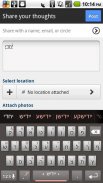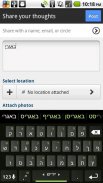




Yiddish Keyboard Plugin

Yiddish Keyboard Plugin介绍
Yiddish Dictionary plugin for Multiling O Keyboard autocorrect and word prediction
Instruction:
⑴ Install this plugin and Multiling O Keyboard. https://play.google.com/store/apps/details?id=kl.ime.oh
⑵ Run O Keyboard and follow its setup guide.
⑶ Slide space bar to switch languages.
If you have font issue, read this: <a href="https://www.google.com/url?q=https://www.google.com/url?q%3Dhttp://honsoapps.appspot.com/1/ma.html%26sa%3DD%26usg%3DAFQjCNG71Nl5i6QMcdEZvU1BqM2L70OWlQ&sa=D&usg=AFQjCNHJAfktVVilzCrduIwvK96EQvYRGw" target="_blank">http://honsoapps.appspot.com/1/ma.html</a>
Wikipedia:
Yiddish (ייִדיש, יידיש or אידיש, yidish/idish, literally "Jewish") is the historical language of the Ashkenazi Jews. It originated during the 9th century in Central Europe, providing the pre-existing language of the nascent Ashkenazi community with an extensive Germanic based vocabulary. Yiddish is written with a fully vocalized alphabet based on the Hebrew script.
The earliest surviving references date from the 12th century and call the language לשון־אַשכּנז (loshn-ashknez = "language of Ashkenaz") or טײַטש (taytsh), a variant of tiutsch, the contemporary name for Middle High German. In common usage, the language is called מאַמע־לשון (mame-loshn, literally "mother tongue"), distinguishing it from Hebrew and Aramaic, which are collectively termed לשון־קודש (loshn-koydesh, "holy tongue"). The term "Yiddish" did not become the most frequently used designation in the literature until the 18th century. In the late 19th and into the 20th century the language was more commonly called "Jewish", especially in non-Jewish contexts, but "Yiddish" is again the more common designation.
Modern Yiddish has two major forms. Eastern Yiddish is far more common today. It includes Southeastern (Ukrainian–Romanian), Mideastern (Polish–Galician–Eastern Hungarian), and Northeastern (Lithuanian–Belarusian) dialects. Eastern Yiddish differs from Western both by its far greater size and by the extensive inclusion of words of Slavic origin. Western Yiddish is divided into Southwestern (Swiss–Alsatian–Southern German), Midwestern (Central German), and Northwestern (Netherlandic–Northern German) dialects. Yiddish is used in a large number of Orthodox Jewish communities worldwide and is the first language of the home, school, and in many social settings among most Hasids. Yiddish is also the academic language of the study of the Talmud according to the tradition of the Lithuanian yeshivas.
The term Yiddish is also used in the adjectival sense, synonymously with Jewish, to designate attributes of Ashkenazi culture (for example, Yiddish cooking and Yiddish music).[4]
</div> <div jsname="WJz9Hc" style="display:none">意第绪语词典插件Multiling o键盘自动更正和单词预测
说明:
⑴安装此插件和Multiling o键盘。 https://play.google.com/store/apps/details?id=kl.ime.oh
⑵运行o键盘,并按照其设置指南。
⑶滑空格键切换语言。
如果您有问题的字体,阅读:<a href="https://www.google.com/url?q=http://honsoapps.appspot.com/1/ma.html&sa=D&usg=AFQjCNG71Nl5i6QMcdEZvU1BqM2L70OWlQ" target="_blank">http://honsoapps.appspot.com/1/ma.html</a>
维基百科:
意第绪语(ייִדיש,יידיש或אידיש,yidish / idish,字面意思是“犹太人”)是德系犹太人的历史语言。它起源于在中欧9世纪,提供新生的德系社区的预先存在的语言,并具有广泛基础的日耳曼词汇。依地写入与基于所述希伯来语脚本完全发声字母表。
现存最早日期的引用于12世纪,并调用语言לשון-אַשכּנז(loshn-ashknez =“语言Ashkenaz的”)或טייַטש(taytsh),tiutsch的一个变种,为中古高地德语当代名。在常见的用法中,语言被称为מאַמע-לשון(MAME-loshn,字面意思是“母语”),从希伯来语和亚拉姆语,它们统称为לשון-קודש(loshn-koydesh,“圣洁的舌头”)区别开来。术语“意第绪语”并没有成为最常用的名称在文献中,直到18世纪。在19世纪末和进入20世纪的语言被更多的通常被称为“犹太人”,特别是在非犹太人的背景,但“意第绪语”又是较常见的标识。
现代依地有两种主要形式。东方意第绪语是更为普遍的今天。它包括东南(乌克兰和罗马尼亚),Mideastern(波兰加利西亚东方匈牙利),以及东北(立陶宛,白俄罗斯)方言。东依地既通过其更大的尺寸和所广泛包含斯拉夫原籍字不同于西方。西方意第绪语分为西南(瑞士阿尔萨斯德国南部),中西部(德国中部),和西北(Netherlandic - 北德文)方言。意第绪语被用于大量全球的正统犹太社区,是家庭,学校的第一语言,并在其中最Hasids很多社会环境。意第绪语也是犹太法典的研究根据立陶宛神学院的传统的学术语言。
该术语意第绪语也使用在形容词意义,同义犹太,指定德系文化的属性(例如,意第绪语烹饪和意第绪语音乐)。[4]</div> <div class="show-more-end">
























